What Is Agentic AI? A Definitive Guide to Autonomous Decision Making
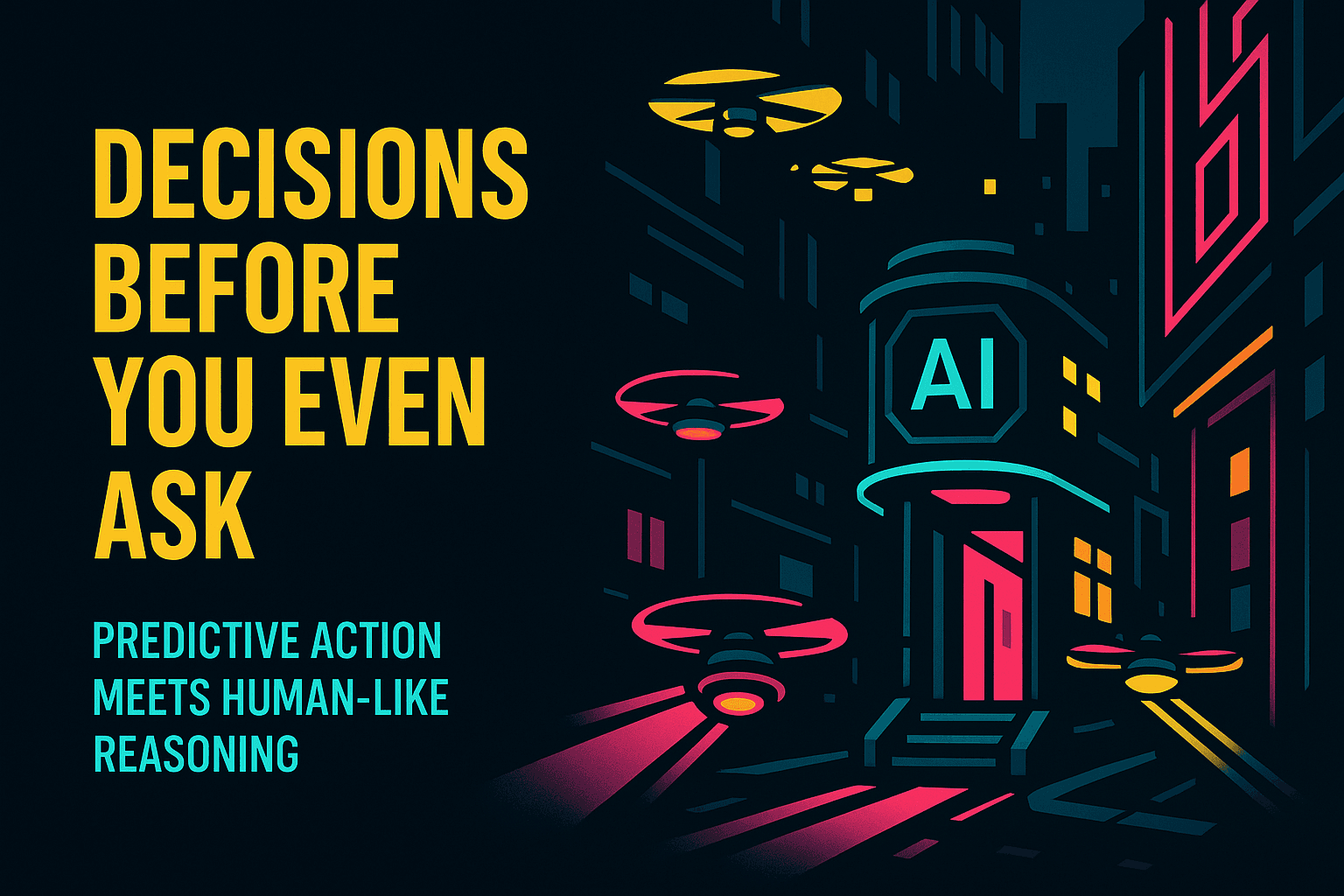
Computers are useless. They can only give you answers– Pablo Picasso
Picasso was right, until he wasn't. For decades, we've treated technology as a sophisticated calculator, feeding it questions and harvesting answers. We became the decision-makers, and technology became our obedient oracles, pointing us toward information but never crossing the line into action.
But something fundamental shifted with large language models. Technology stopped being just a pointer to decision-making and started understanding the pointers themselves. AI began grasping context, interpreting intent, and—crucially—acting on it. Let's dive deeper
Understanding Agentic AI
What Is Agentic AI
Agentic AI describes systems that interpret context, plan the next step, and take action toward a business goal with no or minimal human supervision.
The goal matters more than the wording of a single prompt. A scheduled appointment. A completed verification. A resolved ticket, orchestrating operations that extend over months.
The AI senses, reasons, and executes while staying inside your rules. That is the core promise.
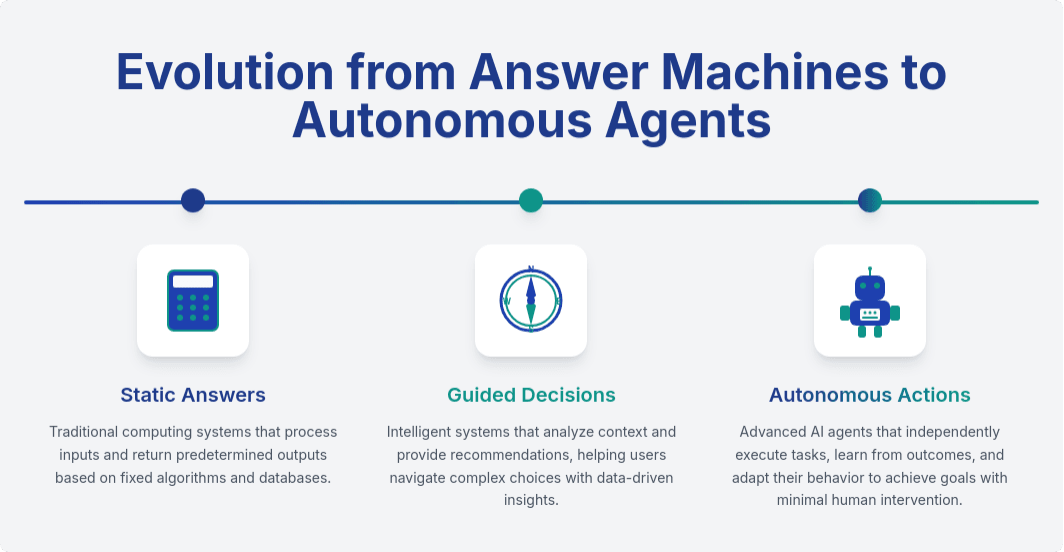
Why Agentic AI Now
A practical wave of ingredients finally lines up.
• Large-language Models can reason and call tools with structured inputs and outputs
• Connectors and adapters make it simple to attach agents to data, applications, and channels
• Evaluation and tracing let teams measure quality, safety, latency, and cost
Put those together, and you can move from chat that replies to systems that produce outcomes. For concept contrast later, see Agentic AI vs Generative AI
Agentic AI Architecture
Think in four clear layers. The pattern is easy to explain and easy to audit.
• Perception collects and interprets signals from text, forms, documents, events, and voice. The result is a working picture of the situation
• Cognition plans and selects the next step using goals, tools, memory, and constraints. Plans update as new information arrives
• Action executes through application programming interfaces, software adapters, robotic steps, or a request to a human when required. Every action returns a result and a trace
• Assurance watches everything with metrics, costs, explanations, and policy checks. It can route to a human or stop the flow when risk rises
This architecture supports one agent or a small team of agents that hand tasks to each other. For decision styles that keep planning reliable, compare ReAct Vs Agentic Planning.
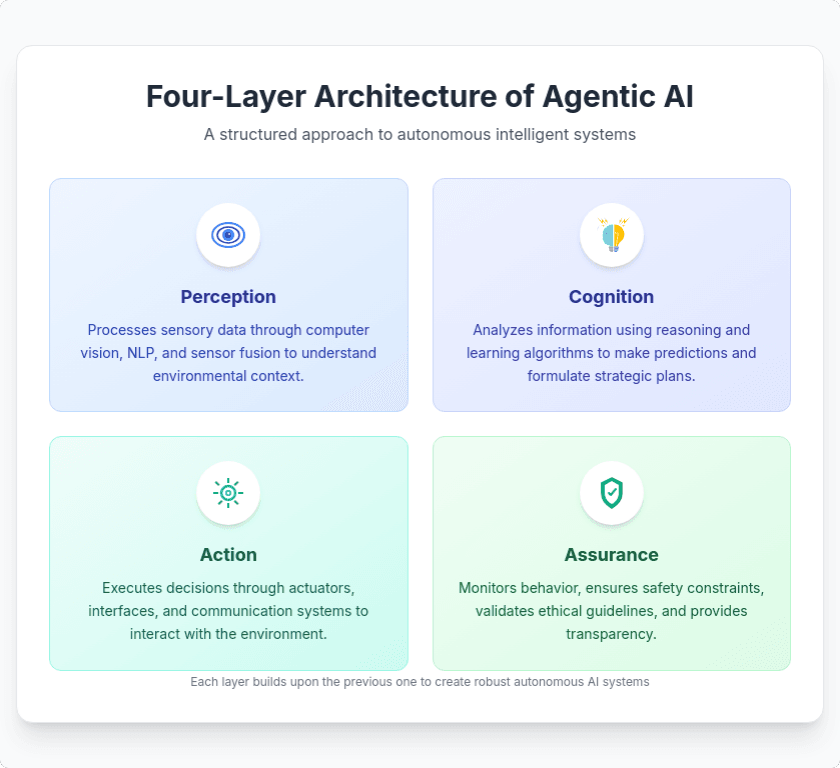
Technical Enablement for Autonomous Action
Autonomy is only useful when it is dependable. That requires plumbing you can trust. Set these capabilities early, and life gets easier.
• Connectors and typed tool calls for CRM, calendar, payments, ticketing, advertising platforms, document storage, and messaging channels
• Memory across sessions grounded in approved knowledge sources, so context follows the customer without asking the same questions again
• Evaluation harness that checks tasks, safety rules, latency, and cost. Include golden tasks and regression checks
• Observability that records inputs, decisions, tool calls, outcomes, and costs with a timeline you can replay
• Fallbacks and recovery with timeouts, retries, and human approval paths for higher risk actions
• Configuration as code for prompts, policies, connectors, and budgets so changes are reviewed and tracked
When teams say an agent is production ready, they usually mean this stack is in place and tested.
Key Characteristics of Agentic AI
Short and specific. These traits show up in every successful deployment.
• Autonomy to decide and act within defined bounds
• Adaptability through feedback loops and recovery paths
• Memory across sessions with retrieval from trusted knowledge
• Tool use with permissions that map to your policy
• Evaluation of outcomes against goals using repeatable tests
• Journey awareness that maintains context across channels and time
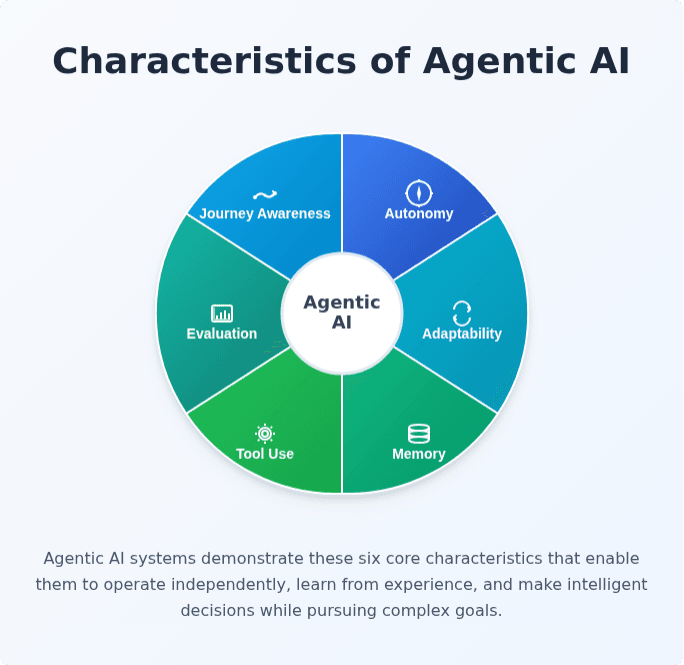
Robotic Process Automation Versus Agentic AI
Both have a place.
• RPA follows fixed rules to perform repeatable steps. It shines when paths are known
• Agentic AI adapts to new information and chooses the next best step. It shines when outcomes matter more than steps
RPA is the steady hands. The agent is the decision maker that decides when and why those hands should move.
Generative AI Versus Agentic AI
Generative AI produces content. Agentic AI produces outcomes. The agent will often use generation along the way. A model drafts a message. The agent decides who should receive it, when to send it, how to follow up, and when to involve a human. That difference changes how teams plan, measure, and staff their programs.
For a messaging perspective, Read Agentic AI vs Conversational AI
Implementation Benefits
Benefits concentrate where friction concentrates. That is good news because you can see them quickly.
• Operational excellence by reducing handoffs and decisions that wait for someone to notice
• Strategic advantage because processes learn and adapt to live market conditions
• Scale with control since agents do more work without a linear increase in headcount, while audits and policies keep pace
• Happier customers and teams because small frustrations vanish and time goes to higher-value work
If leadership is revisiting platform strategy during rollout, this frame pairs well. From System of Records to System of Action
Agentic AI In The Enterprise
Enterprises succeed when they treat agents as new digital workers inside a clear operating model. The model is simple to describe and powerful in practice.
• Define the goals and guardrails for each agent. Be explicit about what it may and may not do
• Connect agents to data through governed access and retrieval, not through unchecked copying
• Wrap tools with adapters that enforce permissions and timeouts
• Observe runs, decisions, and costs in one place so reviews are fast and fair
• Share playbooks for supervisors and responders so the human loop is consistent
Where agents fit in your stack
• Data and knowledge with governed access to systems of record and approved knowledge bases
• Orchestration for routing, planning, retries, and recovery for one agent or a small team
• Tools and adapters for software platforms and internal services
• Observability for traces, metrics, costs, and explanations
• Governance to enforce policies, permissions, and audit across the life cycle
Journey Orchestration Through Autonomous Action
Now the heart of the story. Journey orchestration means agents plan, execute, coordinate, and act based on your brand focus, wherever the customer is in the journey. No constant human intervention required. The agent notices a stall and makes a helpful move in the same channel the person already uses. It can also pause, ask for help, or escalate when risk is high.
A few scenes make this concrete.
• A prospect hesitates on the calendar page. The agent proposes two time windows, confirms the choice, pushes the booking to the calendar, and sends directions
• A form pauses at proof of address. The agent offers a secure capture link, validates the file, files it to the correct vault, and resumes the flow
• Email goes unanswered while chat is lively. The agent switches the conversation to chat without losing context, then nudges a simple next step
How Agentic AI Changes Marketing
Marketing shifts from scheduled broadcasts to continuous decisioning. Agents pay attention to signals, test copy and offers, adjust timing and channel, and choose the next best action for each person. It sounds ambitious. In practice, it is a series of small, safe moves that add up.
Impact across the funnel
• Discovery and research benefit from autonomous audience exploration and fresh insights that show which topics and intents are popular this week
• Creative and offers evolve as agents read engagement and change tone, proof points, or incentives
• Journey continuity improves because context follows the person across email, chat, ads, and site. The next step stays aligned with intent rather than with a calendar
• Retention gets a lift from proactive service and timely value prompts that reduce churn and increase lifetime value
For a broader view of how orchestration shapes customer experience, see Agentic AI for Customer Experience
Unified Customer Understanding Beyond Numbers
Enterprises are rich in numbers. Events, funnel steps, time on task, error counts, opens and clicks. The differentiator now is language and behavior in context. Agents can read the why inside the what.
• Quantitative signals include clickstream, funnel position, dwell time, error codes, and campaign membership
• Qualitative signals include chat transcripts, call notes, free text in forms, support threads, and short session replays
Large language models can infer intent, hesitation, and confusion from those qualitative signals. A pause on the date picker. A string of backspaces on a budget field. A careful tone in chat. When the system detects these subtle cues, it can act in the moment and reduce drop off. Do this with care. Use explicit consent, scoped access, short retention windows, and redaction for sensitive fields. Trust is not a feature. It is the foundation that keeps adoption real. For a wider lens on journey tooling, see Evolution of Customer Journey Technologies.
The Future Multi-Agent Orchestration
As scope grows, teams move from one agent to a small team of agents that collaborate.
• A planner breaks the goal into steps and negotiates tradeoffs
• Specialists handle retrieval, research, integration, or creative tasks
• A reviewer checks outputs against policy and risk, then approves or edits
• An orchestrator coordinates handoffs, resolves conflicts, and manages recovery when a tool fails
This pattern increases reliability without slowing you down. Humans stay focused on supervision and strategy rather than micromanaging each step.
Agentic AI Use Cases
Across industries, organizations face friction at critical moments in the customer journey. Whether due to human response delays, fragmented systems, or overwhelmed users, these friction points stall conversions, increase drop-offs, and raise support costs.
Agentic AI unlocks forward momentum. By adding a real-time, intent-aware automation layer across your existing tools, every message, click, and call can become an opportunity to guide customers toward action.
Explore more here: Agentic AI Use Cases
Healthcare
In healthcare, delays between patient intent and staff response hurt confidence and cost bookings. Manual processes and disconnected systems eat into time meant for patient care.
Agentic AI offers 24/7 empathetic engagement—educating, booking, triaging, and answering questions across any channel. Patients feel heard and supported, while clinics reduce after-hours gaps and manual load.
Impact: More bookings, faster triage, lower acquisition cost, fewer hours spent on admin.
Real Estate
Many real estate teams attract strong leads but lose them to slow follow-ups or confusing scheduling steps. Even high-intent buyers fail to convert when interactions stall.
Agentic AI handles tour bookings on the spot, suggests options, follows up, and keeps buyers engaged—across web, ads, or SMS. It identifies buyer readiness and adapts in real-time.
Impact: Higher tour conversion, faster time to book, fewer missed opportunities.
Fintech
Fintech onboarding is often blocked by drop-offs during form filling, document uploads, or compliance hurdles.
Agentic AI smooths this path—helping customers submit files, verifying uploads, and reducing friction through guided steps across chat, email, or WhatsApp. It plugs into CRMs, payment gateways, and compliance systems.
Impact: Reduced drop-off, faster KYC completion, higher application success.
E-commerce
Even with good traffic and product pages, customers abandon carts due to last-minute confusion, discount issues, or unanswered questions.
Agentic AI engages in the moment—answering product queries, applying codes, and pushing the purchase to completion across chat or email.
Impact: Lower cart abandonment, faster checkout, improved ROI on ads.
Event Management
Event platforms struggle when users hit friction around seating, pricing tiers, or optional extras—leading to drop-offs at the finish line.
Agentic AI helps users pick the best seats, applies offers, and completes checkouts conversationally. Integrated flows across email, SMS, and portals simplify the journey.
Impact: Faster sales cycle, better upsell rates, reduced support queries.
SaaS and B2B
Freemium or trial users often delay upgrades due to complexity, unclear value, or poor timing.
Agentic AI reads intent signals, suggests plans based on usage, and guides hesitant users while converting the ready ones—via chat, email, or LinkedIn.
Impact: Higher conversion to paid, fewer drop-offs, personalized upgrade paths.
Wellness and Fitness
Trial users often bounce between plans or quit due to unclear guidance. Trainers and coaches can’t scale personal attention.
Agentic AI personalizes onboarding, recommends programs, and books sessions—helping users stick with their goals while remembering context across interactions.
Impact: Higher plan adoption, increased bookings, reduced churn.
Customer Support
Support teams are flooded with repeat questions, confused users, and slow escalations.
Agentic AI detects hesitation, guides users proactively, sends reminders, and escalates when needed—all while preserving context across every channel.
Impact: Faster resolution, fewer tickets, better CSAT.
Secure Agentic AI Adoption, Security Compliance, And Guardrails
Autonomy without safety is a stunt. The path to enterprise adoption runs through security and compliance. Treat agents like new identities with scoped permissions and clear supervision. Build controls once and reuse them across journeys.
Guardrails that matter
• Input and output controls that check content and policy before and after an action
• Allow and deny lists for tools, data sources, and destinations with change control
• Dynamic risk scoring that can pause an action or escalate to a human
• Full audit trails with replayable traces for every decision and action. Exportable and retained per policy
• Budget and rate controls so costs are predictable and usage cannot spike without notice
Data protection and compliance
• Data minimization with masking of sensitive fields and access scoped to the task at hand
• Scoped secrets and short-lived credentials with rotation and monitoring
• Retention and deletion aligned to your policy and the region where data lives
• Vendor and model governance with an approved catalog and impact assessments before production
Align to the frameworks and regulations that buyers and auditors trust. That includes GDPR for data rights and transparency, HIPAA where health information is involved, and SOC 2 aligned with AICPA for controls and assurance. Regional laws and industry rules may add obligations, so coordinate with counsel before you expand. For a structured view that speaks the language of risk and audit, see Responsible AI for Enterprises
Human in the loop
• Define supervision points where a reviewer must approve, edit, or reject decisions
• Use thresholds for value and risk
• Capture reviewer feedback in a structured way so agents and prompts improve
• Document how to escalate, how to roll back, and who is on call
Agentic AI Implementation Roadmap
Slow is smooth and smooth becomes fast. Ship value in a measured way and you will earn the support to scale.
• Choose one high value workflow that touches real data and real tools. Make the outcome measurable and valuable
• Define success measures for quality, safety, latency, and cost. Agree on targets before you start
• Instrument evaluation with golden tasks, offline tests, and canary traffic. Track regressions over time
• Layer guardrails and logging before expanding tool scope. Prove that oversight works
• Pilot with one team then expand to multiple teams and multiple agents. Share patterns and reusable components
• Enable supervisors with training, runbooks, and approval rubrics so oversight is consistent
• Scale in stages by adding one more action, one more channel, then a second journey. Keep budgets and audit reports visible
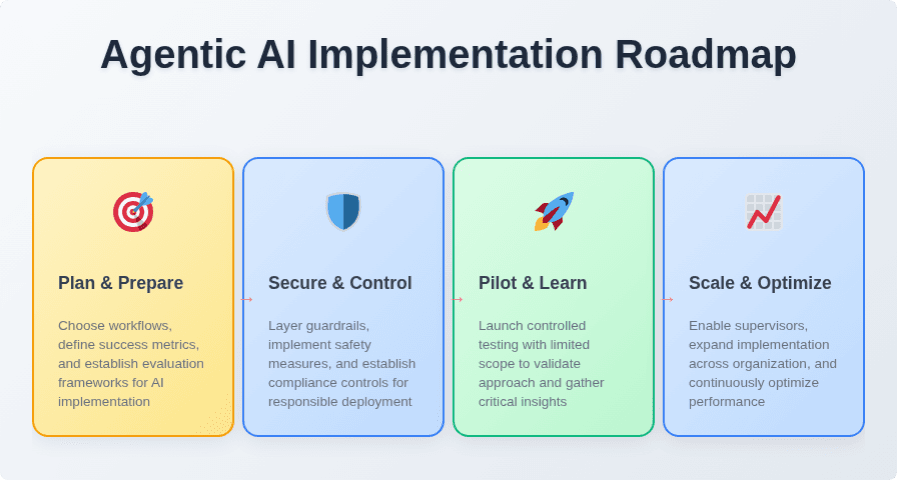
Conclusion
Agentic AI is not another chat box. It is an operating model that marries autonomy with governance. Agents pay attention to signals, plan useful moves, act through safe tools, and learn from outcomes. Security and compliance keep that autonomy inside clear lines. The result is momentum you can measure. Faster decisions. Fewer stalls. Better journeys.
About Zigment
Zigment helps enterprises move from chat to action with a platform built for governed autonomy. Two ideas anchor our approach, and they matter most in production.
• Conversation Graph maps the moments that matter across channels and surfaces the exact stall where an autonomous action can help. It is simple to explain and easy to audit. Explore the concept
• Customer OS connects approved data, tools, and guardrails so agents can act safely inside your stack. It gives teams a shared view of context, permissions, and cost. Learn more...
If you are evaluating platforms, ask us to show a live stall recovery with full traces, budgets, and approvals. No theater. Just the moment where a customer hesitates and the system quietly helps.
Start with one autonomous action that clears a real block, wire in evaluation and guardrails, then expand with confidence. Your customers will feel the difference and your teams will get time back for the work only people can do.